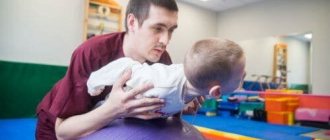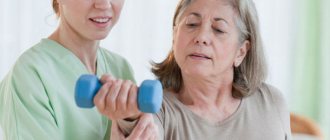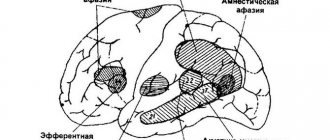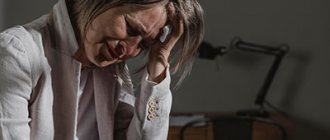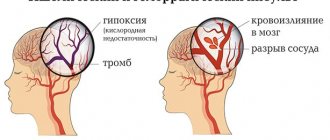What is cerebral palsy?
Cerebral palsy is a pathological disease. If a child is diagnosed with this, it means that a certain part of the brain is affected.
The extent and nature of the disease can be determined at approximately 2 months of age.
There are cases when several departments are affected. Paralysis of the central nervous system can occur in a child while he is in the womb, as well as after birth.
This disease is quite serious and can develop over time. To prevent the situation from worsening and increase the likelihood of its correction, it is necessary to perform various exercises using special techniques.
Important ! Independent exercise therapy exercises for cerebral palsy are possible, but it is best to use the help of special medical exercise therapy instructors.
The role of massage in the treatment of cerebral palsy in children.
Massage for children with cerebral palsy is always prescribed, but in the treatment process it still plays one of the main roles, not the main one. What is most important in the treatment of cerebral palsy cannot be said unequivocally, I would highlight the most important: drug treatment, exercise therapy (in all its diversity), massage, and in the late recovery period, orthopedic devices such as corsets, splints, verticalizers. The role of massage is great in conjunction with the above effective methods of treatment, and small when used alone. You have to act without massage if it turns out to be contraindicated, this happens when epilepsy or convulsions accompany the main diagnosis.
The importance of exercise therapy
During the rehabilitation period for cerebral palsy, special importance is given to the therapeutic and physical training complex of exercises. This load successfully helps:
- develop spontaneity and ease of inhibition of movements;
- reduces hypertonicity of muscle tissue;
- has a positive effect on coordination of movements;
- helps improve joint mobility;
- acquire necessary skills in everyday life;
- has a beneficial effect on the ability to self-service.
It is necessary to start exercises for children with cerebral palsy at an early age.
Exercise therapy not only promotes the development of muscles and mobility, but also makes the brain of a sick child more plastic. The risk of severe mental retardation is reduced.
Attention ! There are no general contraindications to exercise therapy for children with cerebral palsy.
There are personal prohibitions on performing specific exercises, but these can only be clarified with your doctor.
Therapeutic exercise includes many different complexes, you can always choose the right one.
Goals and objectives of massage for cerebral palsy in children.
The goals of massage in the treatment of cerebral palsy in children are to reduce spasticity; prevention of the formation of contractures, prevention of stagnation of metabolic processes, extinguishing pathological reflexes, normalizing the functioning of the nervous system, as far as possible. To achieve such goals, it is necessary to solve problems to improve the mobility (elasticity) of tendons, relaxation of muscles and ligaments.
Goals such as a cure for a disease are difficult to achieve; in most cases, it is not possible to completely cure a child. Goals must be realistic, often they are long-term, so I recommend that parents save their nerves, strength and resources for long-term rehabilitation of the child. Don’t be fooled by promises to “get your child back on his feet,” those who work with such diagnoses understand perfectly well that miracles don’t happen, and someone takes advantage of the parents’ feelings and makes money from it. Achieving results in rehabilitation always requires a lot of work by specialists, the child and parents.
Exercise program
An exercise program for children with cerebral palsy should include the following types of loads:
- Complex for muscle stretching. To prevent teratogenesis, it is necessary to develop muscle mobility. This will help relieve tension and increase the range of motion.
- Exercises to maintain the sensitivity of muscle tissue and its development. This helps regulate the force of interaction with specific muscles, allowing you to perform everyday rituals in everyday life.
- Load to improve the response of nerve endings. Positively affects the functionality of nervous tissue.
- Program for improving antagonistic muscles.
- A complex aimed at developing endurance, stamina, and discipline of the body.
- Exercises that help strengthen normal walking and correct gait.
- Loads to maintain balance. Vestibular apparatus training.
You should pay special attention and concentration to the set of classes carried out at home!
| Purpose of the exercise | Type of exercise |
| To maintain or increase joint mobility | 1. range of motion exercises 2. stretching exercises |
| To maintain or increase strength | 3. strengthening exercises with movement: exercises that work the muscles and move the joint against resistance. 4. strengthening exercises without movement: exercises that work the muscles without moving the joint. |
| To improve the situation | 5. practice holding things or practice doing something in a good position |
| To improve control | 6. practice of performing certain movements and actions to improve balance or control |
All potential training programs must be agreed upon with your doctor and the technique of performing each exercise thoroughly studied.
Voight technique
The program was named after its creator, who proposed using the reflex of cognition and turns for the purpose of rehabilitating a sick child with cerebral palsy. Each sick child receives individually developed complex exercises that can be adjusted.
A child’s best assistant in the rehabilitation process is a close person whom he trusts.
The main role in the program is given to relatives, since they are the ones who must conduct classes with the patient several times every day. That is why during the rehabilitation period parents must undergo training so that there are no difficulties with training. The healing process based on Voight therapy can be carried out starting from birth. But, parents should be prepared for the fact that the patient will not always be calm during the exercises. Moreover, this is associated, rather, with fear than with the manifestation of pain.
Voight technique in video:
Exercises in the pool
Water for children has always been a source of joy, fun, and carefree. Children with cerebral palsy are, of course, no exception.
Water procedures are carried out for no more than 30 minutes . You should not overwork your muscles.
It is better to conduct classes regularly, patiently achieving results, than at one time, which will not bring success.
Exercises must be performed gradually, in complexes.
Step 1
The first 2-3 classes are conducted on land by the pool, without contact with water.
It is necessary to explain to the child how to move correctly in the water. It is necessary, through gymnastics, to teach the patient to move his arms and legs correctly.
Step 2
When going into the water for the first time, you should be very careful. Children with cerebral palsy are easily frightened and may not understand contact with water.
The child will need additional support, both physical and moral. However, it should be noted that children get used to swimming very quickly.
Step 3
Next, attention is paid to warming up the arms. Movements of the upper limbs during swimming help strengthen the cervical vertebrae.
It is necessary to show the child how to move his hands correctly. The first swings must be smooth and slow. The muscles will have to get used to the changes. In the next lessons, they begin to accelerate the rotation.
Step 4
Later, credit is given to the movement of the legs. Due to the incorrect development of the musculoskeletal system in children with cerebral palsy, it is necessary to correct this in the pool.
A good way is to jump in water. To perform them, it is recommended to hold the baby’s hands.
Hand massage for children with cerebral palsy.
Hand massage for a child with cerebral palsy is carried out according to the same principle as massage of the lower extremities. Relaxing massage of spastic muscles is usually the flexors of the forearm, hand, fingers, adductors of the arm, pronator of the hand and forearm. A relaxing hand massage begins from the upper sections, i.e. adductors, pectoralis major muscle, latissimus dorsi muscle and their synergists. We apply passive movements in the shoulder joint to the warmed and stretched muscles to stretch the muscles. Next, we stretch the biceps on the shoulder and tone the triceps, and continue passive extension at the elbow joint. We massage the forearm taking into account the tone and make passive movements in the LZS and it is important not to forget about the pronators, after the massage we stretch them with supination, also passive. If the fingers are in a fist, then we massage the hand and stretch the finger flexors by extending the wrist joint with the fingers previously unclenched and fixed.
Rules for performing exercises
First of all, it is necessary to follow the basic rules regarding the set of exercise therapy exercises for children with cerebral palsy:
- classes must be regular;
- approach – individual to each child;
- you should maintain systematic training without interrupting it;
- the increase in loads should occur gradually and strictly under the supervision of a doctor;
- When prescribing a complex, the severity of the pathology and the mental development of the patient must be taken into account.
Each child is individual. No one other than parents and a doctor can determine whether a particular technique is suitable for an exceptional child.
Is it possible to teach massage to parents with cerebral palsy?
It is possible to learn some basic techniques of massage and gymnastics, but it is better for parents to use them between courses, as homework. It will, of course, be more effective to work with a specialist, and the parents’ task is to maintain joint mobility and muscle stretching until the next course of massage, to the extent they can. This approach saves time on the next massage course. Those. The massage therapist no longer spends several sessions trying to return the muscles to their previous state in which they were left on the previous course.
Massage in exercise therapy
Any massage serves as an auxiliary, but very important element for cerebral palsy deviations. Massage for a child with cerebral palsy should begin as soon as an accurate diagnosis is made.
It normalizes blood circulation, improves metabolism, has a beneficial effect on muscle tissue, and relieves spasms.
There are three main types of massage for cerebral palsy:
- classical;
- segmental;
- spot.
After familiarizing yourself with each method in detail, parents can do the massage themselves at home.
Classic massage is aimed at relieving spasms from tense muscles and toning weakened ones. This helps to change the child's distorted postures.
Movements during the procedure should be smooth and slow. The skin should not move with the hand.
The following stimulation methods are used:
- continuous stroking warms and relaxes muscles;
- felting – used to target large muscle groups;
- skating – ideal for influencing the hip and shoulder joints;
- deep intermittent stroking – suitable for maintaining tone in muscle tissue;
- rubbing with the outer part of the palm – the ribbed surface helps stimulate large muscles (buttocks, back, thigh);
- light tapping, pinching.
Therapeutic foot massage for children with cerebral palsy.
Two legs of an adult with aching joints
Almost all forms of cerebral palsy affect the limbs. Most often you have to work with muscle spasticity. The legs are the most difficult area due to the massiveness of the muscles. Despite the fact that the child may be small, the leg muscles are already so strong that you have to make a lot of effort and spend a lot of time on them to achieve any lasting relaxation. Leg massage for cerebral palsy in children can be carried out according to the classical scheme, but techniques for stretching spastic muscles are required, this greatly helps to relax the muscles. You can even say that massage is a preliminary warm-up for the muscles before stretching. We start massaging with stroking techniques, but this is only the first contact, so to speak, to notify the nervous system about the beginning and nature of the procedure, then rubbing, kneading, vibration techniques. Most of all, of course, we use kneading, which we alternate with stretching muscle groups. Spasticity in the legs in most cases affects the posterior muscle groups of the thigh and lower leg, adductors, pelvic muscles, and iliopsoas. The internal muscles of the pelvis can only be affected by stretching. Therapeutic leg massage for children with cerebral palsy is done at a slow pace, deeply, with an emphasis on the calf muscles, shin flexors, with the study of similarities and places of their attachment to the bones, alternating with passive, stretching spastic muscles, movements in the hip, knee and ankle joints. I also consider it important to have a tonic massage of antagonists of spastic muscles. We carry it out deeply at a fast pace so that the muscles tense. When the muscles of the antagonists are tense, the tense muscles relax better.
Auxiliary training equipment
It is best to have additional exercise equipment at home for early development.
A rug with an uneven surface covered with small bumps
It is necessary to teach the child to walk on it with bare feet. It is better to focus on your heels. This is where the largest number of nerve endings are concentrated.
Another undoubted advantage of the procedure is the normalization of blood circulation. To create more interest in this activity for the child, it is recommended to paint the rug, apply interesting appliqués and patterns.
This decision will contribute to intellectual development.
Special expander
Nowadays there are already quite a few similar simulators for the development of grasping reflexes. But before, beautiful rag bags with cereals (buckwheat, rice) were used.
This remedy also eliminates finger spasticity (spasm or cramp).
Dolphin therapy
It is believed that such a rehabilitation technique is the most pleasant, since it is based on communication between the patient and the dolphin. Communication with emotional marine mammals has a positive effect on the mental state of sick children.
Dolphins are specially trained and will not harm small patients
Effective use of such therapy allows you to change your attitude towards yourself and others, as well as reduce isolation. When communicating with dolphins, patients with cerebral palsy activate their nervous activity, which leads to improvements in speech, motor abilities and the development of intelligence. But, it should be remembered that such classes should be conducted with the direct participation of rehabilitation doctors, trainers and relatives. No, you need to be afraid of the dolphin’s manifestations of aggression, since mammals are specially trained for such programs.
Story about dolphin therapy:
Causes of spastic diplegia
- Prematurity. Premature birth is caused by early placental abruption, incompatibility between the blood of mother and fetus, uterine abnormalities, and maternal diseases such as diabetes, gestosis, and renal pathologies.
- Birth injuries. They can be inflicted on the fetus during prolonged or rapid labor or an excessively narrow pelvis. As a rule, birth injuries are a consequence of intrauterine development disorders.
- Fetal asphyxia. Hypoxia during pregnancy and childbirth.
- Toxic effects on the fetus. Spastic diplegia occurs as a result of maternal abuse of alcohol, drugs, nicotine, and the onset of the disease can also be caused by taking medications prohibited for pregnant women.
Heredity also has an influence. Sick people are less likely to have a healthy baby.
Diagnosis of spastic diplegia
Diagnosis consists of a comprehensive examination of the child. Not only the medical history of the neurology of cerebral palsy and spastic diplegia is studied; Ophthalmological and otolaryngological examinations are used: an examination is carried out to determine the presence of hearing and vision impairments.
The specialist studies the pregnancy history and conducts a neurological examination of the patient, often using metameric techniques.
In addition, the following diagnostic measures are implemented:
- CT;
- MRI of the brain;
- Sometimes electroneuromyography. Used to exclude muscle diseases;
- Ultrasound of head and neck vessels;
- mental diagnostics. At an earlier age it is carried out by a neurologist, later by a child psychiatrist.
Depending on the severity of the disease, the specialist develops therapy.
Dynamic proprioceptive correction technique
A special feature of this technique is motor rehabilitation using special Graviton devices. This is a design using elastic traction; it is assembled individually for each patient based on clinical studies. It is worth noting that complex training is developed individually based on the existing movement disorder.
Elastic traction allows you to gradually develop muscles
A sick child should approach such therapy only after he or she reaches the age of three; such treatment according to the program lasts about three weeks. Sometimes, for greater effect, the duration of treatment can be increased to one and a half months. Any manipulations within the framework of this method should be carried out only on the strict recommendation of a doctor and under his direct supervision.
